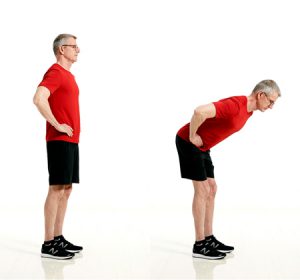7 Genius Form Fixes That Physical Therapists Wish You Knew
Minimize your injury risk and maximize your results with these small tweaks from the pros.

During workouts, nothing is more important than exercise form. And learning proper technique involves more than mirroring an instructor or even following exercise instructions to the letter.
“To find the right form, it’s important to pay attention to both how your joints feel and which muscles you feel working during any exercise,” explains Shannon O’Neill, D.P.T., a physical therapist and certified personal trainer at BioFit in Overland Park, Kansas.
The human body is incredibly adaptable, so if one muscle isn’t doing its job, another is more than happy to pick up the slack. When that happens, you may be in picture-perfect form, but you might as well be performing a completely different, potentially unsafe exercise, says John Kim, D.P.T., a physical therapist at React Physical Therapy in Chicago.
The takeaway: Figuring out the right exercise form for your body is absolutely worth the time and energy investment. Start today with these simple cues for adjusting your form based on what you’re feeling. Your stronger, injury-free future self will thank you.
You Feel: Your Shoulders Popping or Grinding
Try This: Engage Your Upper Back

The shoulders are the most mobile—and unstable—joints in the human body. So if you aren’t fully engaging the muscles that support those joints, your upper-arm bone can easily rattle around, grind, or otherwise annoy your shoulder socket, O’Neill says.
If you feel popping or grinding in your shoulders during rows, raises, presses, or other exercises that require you to move your arms up and down or back and forth, tune in to what’s going on in your upper back. Are you engaging the muscles there—or are you just going through the motions like a limp noodle?
Focus on bracing your upper back, creating tension and squeezing those muscles for proper support. There’s a good chance your shoulder woes will end right there, O’Neill says.
Want to give your shoulders more support? Try this upper-back workout you should do every week.
You Feel: High-Impact Exercises Hurt Your Joints
Try This: Eliminate Noise as You Land
“When it comes to jumping, it’s usually the landing, not the jumping, that gets people in trouble,” O’Neill says. “If people want to jump—such as in jump squats or scissor lunges—think about absorbing the impact, using your muscles as you land to make no noise.”
This simple mental switch will make you control the descent, as opposed to simply letting your weight drop to the floor. Remember: Even during an exercise’s eccentric or “easy” half, the body should still be active and working.
Not sure if high-impact exercise is right for you? Start by talking to your doctor, especially if have osteoporosis, arthritis, or diabetes. If you get the okay, increase impact gradually—you want to be able to do jumping jacks safely before trying jump squats, for example. Learn more in our guide to high-impact exercise for older adults.
You Feel: An Achy Back During Hip Hinges or Deadlifts
Try This: Push the Floor Away with Your Feet

Most people focus on trying to “stand up” when doing hip hinges or deadlifts. That’s not such a bad thing, but if you switch your focus to pushing the floor away with your feet, you automatically engage more muscles in your lower body—especially your glutes to get you in that upright position, Kim says.
Meanwhile, you reduce your risk of straining your lower back since more, bigger muscles are engaged to raise your torso.
Another tip: Traditional deadlifts involve lifting a heavy weight, usually a barbell, straight off the floor and are difficult to do with proper form. Pulling the weight up takes a lot of strength in your hip and torso muscles to keep your lower back in a safe position.
Thinking about pushing the floor away with your feet certainly helps, but if you’re new to strength training or have back or hip problems, skip the deadlift and perform a hip hinge instead. You can always add weight once you’ve mastered the movement.
You Feel: Your Knees Cave in During Squats
Try This: Push Your Weight to the Outer Edges of Your Feet
“If your foot isn’t properly aligned, nothing else up the chain will be,” says O’Neill. When your foot collapses, she explains, your knee turns in—a very common occurrence during squats.
“If you look down and your knee is falling inward, push more weight to the outer edge of the foot,” she says.
Make sure your pinky toe is in contact with the floor. If your shoes are getting in the way, don’t be shy about wearing only socks—as long as your gym is cool with it and your balance is good. You’ll likely feel your glutes engage right away after making this adjustment.
The squat is one of the very best exercises you can do, especially as you get older, so it’s worth taking the time to perfect your form. And if you can’t do them standing up, you’ll still benefit from doing them in a chair. Learn more in our beginner’s guide to the squat.
You Feel: Everything But Your Glutes During Glute Bridges
Try This: Push Through Your Heels

“When performing a glute bridge, patients will often attempt to lift themselves up from their hip flexors and quads,” says Michael Silverman, M.P.T., a physical therapist and director of operations at Rothman Orthopaedic Institute in New York.
“I instruct patients to flex their feet, toes up, and drive through their heels,” he says. “Doing this helps them engage their glutes, the primary muscles being worked with this activity.”
Subscribe to our newsletter
It's quick and easy. You could be one of the 13 million people who are eligible.
Already a member? Click to discover our 15,000+ participating locations.
Follow Us
It’s also common to feel pressure on your lower back during this movement. That often means you’ve raised your hips too high, allowing your lower back to arch. To fix this, focus on bracing your core and lifting your hips just high enough to engage your glutes. You’ll know you’re in the right position if your body forms a straight line from your knees to shoulders.
Master the glute bridge with our guide to the best bodyweight exercises for older adults.
You Feel: Irritation in Your Hip Flexors
Try This: Imagine You’re About to Get Punched in the Gut
The hip flexors are the muscles in the front crease of your hip, at the top of your thighs. Tight hip flexors are a common complaint among exercisers of all ages, but it’s important to realize that tight muscles are generally weak, overused muscles, Kim says.
When performing exercises that irritate your hip flexors, try bracing your core. Create maximal tension—making your torso as rigid as possible—as if someone is about to punch you in the gut.
This will engage your transverse abdominis, or your deepest core muscle, which is involved in hip flexion and drawing your knee up toward your chest. When it’s active and doing its job, it’s easier to not overuse your hip flexors, Kim says.
Plus, it’s important to engage your core all of the time, no matter what you’re doing. This simply helps promote that healthy habit.
You Feel: Knee Pain During Lunges
Try This: Take a Bigger Stance

Lunges get a lot of flak for irritating the knees. If that happens to you, you might be performing lunges with your weight shifted forward over your lead knee and very little weight in your posterior chain, or the backside of your body, Silverman says.
By taking a wider stance—meaning you step farther forward during forward lunges or farther backward during back lunges—you allow yourself to shift your weight to your hips, engaging your glutes, hamstrings, and back to take some of the load off the front knee, Silverman says. “If you’ve never felt your glutes burn in lunges before, get ready!”
If that doesn’t work, try one of these other lunge modifications that make them easier on your knees.
Take Your Favorite SilverSneakers Classes Online!
SilverSneakers members can access live fitness classes and wellness workshops through SilverSneakers LIVE. See the latest schedule and RSVP for classes here.
Not a member? If you have a Medicare Plan, it may include SilverSneakers—at no additional cost. Check your eligibility instantly here.





